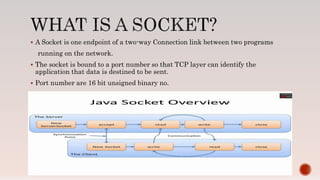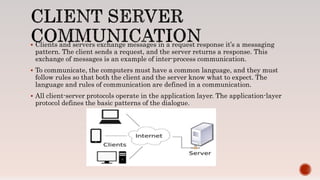Java Networking
- 1. Roll No: 51 – 60 Topic : Java Networking
- 3. Java Networking is a concept of connecting two or more computing devices together so that we can share resources. Java socket programming provides facility to share data between different computing devices.
- 4. A Socket is one endpoint of a two-way Connection link between two programs running on the network. The socket is bound to a port number so that TCP layer can identify the application that data is destined to be sent. Port number are 16 bit unsigned binary no.
- 5. TCP: Transmission Control Protocol provides reliable communication between the sender and receiver. TCP is used along with the Internet Protocol referred as TCP/IP. java.net.Socket – For Client implementation Java.net.Server.Socket – For Server implementation UDP: User Datagram Protocol provides a connection-less protocol service by allowing packet of data to be transferred along two or more nodes
- 6. Public Input Stream getInputStream() Return the input stream attached with this socket. Public Output Stream getOutputStream() Return the output stream attached with this socket. Public Synchronized void close() Closes this Socket. Public Socket accept() Return the socket and establish a connection between client & server. Public Synchronized void close() Closes the server socket.
- 7. Clients and servers exchange messages in a request response it’s a messaging pattern. The client sends a request, and the server returns a response. This exchange of messages is an example of inter-process communication. To communicate, the computers must have a common language, and they must follow rules so that both the client and the server know what to expect. The language and rules of communication are defined in a communication. All client-server protocols operate in the application layer. The application-layer protocol defines the basic patterns of the dialogue.
- 8. When a bank customer accesses online banking services with a web browser (the client), the client initiates a request to the bank's web server. The customer’s login credentials may be stored in a database, and the web server accesses the database server as a client. An application server interprets the returned data and provides the output to the web server. Finally, the web server returns the result to the client’s display. In each step of this sequence of client–server message exchanges, a computer processes a request and returns data. This is the request-response messaging pattern. This example illustrates a design pattern applicable to the client–server model: separation of concerns.
- 9. ADVANTAGES & DISADVANTAGES OF THE CLIENT-SERVER MODEL Advantage Disadvantage the client-server model is centralized architecture helps make it easier to protect data with access controls that are enforced by security policies. The client-server model is that if too many clients simultaneously request data from the server, it may get overloaded. it doesn't matter if the clients and the server are built on the same operating system because data is transferred through client- server protocols that are platform-agnostic. In addition to causing network congestion, too many requests may result in a denial of service.
- 10. import java.io.*; import java.net.*; public class MyServer { public static void main(String[] args){ try{ ServerSocket ss=new ServerSocket(6666); Socket s=ss.accept();//establishes connection DataInputStream dis=new DataInputStream(s.getInputStream()); String str=(String)dis.readUTF(); System.out.println("message= "+str); ss.close(); }catch(Exception e){System.out.println(e);} } }
- 11. import java.io.*; import java.net.*; public class MyClient { public static void main(String[] args) { try{ Socket s=new Socket("localhost",6666); DataOutputStream dout=new DataOutputStream(s.getOutputStream()); dout.writeUTF("Hello Server"); dout.flush(); dout.close(); s.close(); }catch(Exception e){System.out.println(e);} } }









![import java.io.*;
import java.net.*;
public class MyServer {
public static void main(String[] args){
try{
ServerSocket ss=new ServerSocket(6666);
Socket s=ss.accept();//establishes connection
DataInputStream dis=new DataInputStream(s.getInputStream());
String str=(String)dis.readUTF();
System.out.println("message= "+str);
ss.close();
}catch(Exception e){System.out.println(e);}
}
}](https://image.slidesharecdn.com/uscs302javanetworking-220111140522/85/Java-Networking-10-320.jpg)
![import java.io.*;
import java.net.*;
public class MyClient {
public static void main(String[] args) {
try{
Socket s=new Socket("localhost",6666);
DataOutputStream dout=new DataOutputStream(s.getOutputStream());
dout.writeUTF("Hello Server");
dout.flush();
dout.close();
s.close();
}catch(Exception e){System.out.println(e);}
}
}](https://image.slidesharecdn.com/uscs302javanetworking-220111140522/85/Java-Networking-11-320.jpg)

